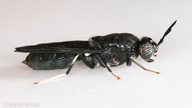
Or, the Riddle of the Moving Wriggle
I harvested the last of my spring potatoes earlier this month. The "grow bags" were too degraded for further use and went into the compost(s), but the one hard-sided potato planter (okay, kitty litter bucket) contained really nice soil still, once I got down past the stem-cover layer. Impressively good soil, actually; rich and dark and springy/spongy, exactly the way soil is supposed to be but container-mix at the end of a growing season never is. Checked my records and confirmed that I'd planter-finished EM bokashi for that unit.
This was my first root-crop harvest from planter-finished bokashi; I’d been a little concerned that remaining undecomposed bits might cause problems, but for whatever reason, that was not the case here. No corn-cobs came up with the russets, no dessicated citrus warped the tubers in the growing. The only things that came out of that planter were yummy potatoes, pulled weeks late without harm. Potatoes produced through a standard top-layering practice using mainly dried leaves with only the bokashi-amended soil for nourishment.
Definitely something I'll do again. But I try not to plant the same thing in the same soil twice in a row. And besides, it's not potato-planting season...
As I had no immediate need for that planter once the potatoes were out, I tossed the leafy stem-cover back in by way of mulch and decided to let it rest awhile. Sunday, I found a matching bucket, so set about creating a sub-irrigation nested set. Step one of my planter conversion required having both buckets empty.
Imagine my surprise upon upending that bucket: An inch or so of dry mulch, then lovely soil full of worms!
I don't really expect Verne and Company to go wandering. They should stay in their towers where I put them. But I didn't put any earthworms in any containers at all, so those grey ones, at least, immigrated from elsewhere. I suppose the red ones might have as well; in this area, I'm hardly the first person to have tried keeping them, and there's more than enough leafy matter around to house a few strays. Still can’t quite wrap my head around the fact that worms can get up onto the porch, but it’s happened before.
Wherever they came from, the volunteer planter-worms did a lovely job turning the leafy matter (and any remaining bokashi) into beautiful rich planting medium, and I took full advantage. The worms themselves, no matter their color, I placed into a spare tower layer for now. Except for the ones I doubtless missed during my harvesting.
I want more. More incredible soil improved and mixed in place. More happy, healthy plants. More worms moving into planters! I’ll be watching the plants potted up with this batch quite hopefully...
Spontaneous in-planter vermicast is a lovely gift; planned in-planter creation would be better still. The vermilit says worms won’t last long in a container once the food’s gone, which makes sense; conventional container gardening says not to include uncomposted material, as the decomposition process can sequester or even remove plant-required nutrients and alter soil pH. But if you could find the right balance of food to worm to plants, could you, maybe, have self-refreshing soil? Soil that would actually improve throughout a season, that would feed plants all the time without risk of salt build-up or burning?
Hey, it’s worth a try. If I get it wrong, the worms will just emigrate. Apparently, they’re much more mobile than I think!








